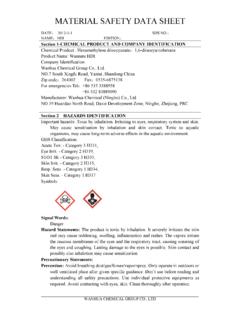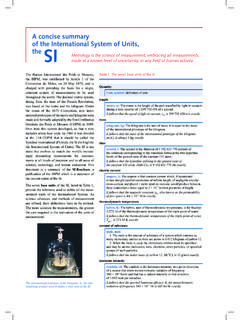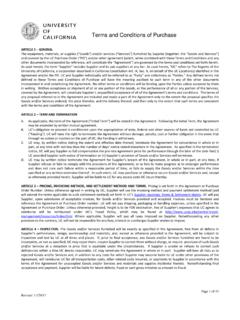Transcription of Hazard Communication Guidelines for Compliance
1 Hazard Communication Guidelines for Compliance Department of Labor Occupational Safety and Health Administration OSHA 3111. 2000 (Reprinted). This informational booklet is intended to provide a generic, non-exhaustive overview of a particular standards-related topic. This publication does not itself alter or determine Compliance responsibilities, which are set forth in OSHA standards them- selves and the Occupational Safety and Health Act. Moreover, because interpretations and enforcement policy may change over time, for additional guidance on OSHA Compliance require- ments, the reader should consult current and administrative inter- pretations and decisions by the Occupational Safety and Health Review Commission and the Courts.
2 Material contained in this publica- tion is in the public domain and may be reproduced, fully or partially, without permission of the Federal Government. Source credit is requested but not required. This information will be made available to sensory impaired individuals upon request. Voice phone: (202) 693-1999. For sale by the Government Printing Office Superintendent of Documents, Mail Stop: SSOP, Washington, DC 20402-9328. ISBN 0-16-049730-2. Hazard Communication Guidelines for Compliance Department of Labor Alexis M. Herman, Secretary Occupational Safety and Health Administration Charles N. Jeffress, Assistant Secretary OSHA 3111. 2000 (Reprinted). Contents iii Introduction.
3 1. Becoming Familiar with the Rule .. 2. Identifying Responsible Staff .. 5. Identifying Hazardous Chemicals in the Workplace .. 6. Preparing and Implementing a Hazard Communication Program .. 8. Labels and Other Forms of Warning .. 9. Material Safety Data Sheets .. 10. Employee Information and 12. Other Requirements .. 15. Checklist for Compliance .. 16. Further Assistance .. 17. Other Sources of OSHA Assistance .. 18. Safety and Health Program Management .. 18. State Programs .. 18. Consultation Services .. 19. Voluntary Protection Programs .. 19. Training and 19. OSHA Related Publications .. 21. States with Approved Plans .. 22. OSHA Consultation Project Directory.
4 25. OSHA Area Offices .. 27. Contents Introduction 1. OSHA's Hazard Communication Standard (HCS) is based on a simple concept that employees have both a need and a right to know the hazards and identities of the chemicals they are exposed to when working. They also need to know what protective measures are available to prevent adverse effects from occurring. OSHA. designed the HCS to provide employees with the information they need to know. Knowledge acquired under the HCS will help employers provide safer workplaces for their employees. When employees have infor- mation about the chemicals being used, they can take steps to reduce exposures, substitute less hazardous materials, and establish proper work practices.
5 These efforts will help prevent the occurrence of work-related illnesses and injuries caused by chemicals. The HCS addresses the issues of evaluating and communicating chemical Hazard information to workers. Evaluation of chemical hazards involves a number of technical concepts, and is a process that requires the professional judgment of experienced experts. That's why the HCS is designed so that employers who simply use chemicals rather than produce or import them are not required to evaluate the hazards of those chemicals. Hazard determination is the responsibility of the manufacturers and importers of the chemicals, who then must provide the Hazard information to employers that purchase their products Employers that do not produce or import chemicals need only focus on those parts of the rule that deal with establishing a work- place program and communicating information to their workers.
6 This publication is a general guide for such employers to help them determine what the HCS requires. It does not supplant or substitute for the regulatory provisions, but rather provides a simplified outline of the steps an average employer would follow to meet those requirements. Introduction 2 Becoming Familiar with the Rule OSHA has provided a simple summary of the HCS in a pamphlet entitled Chemical Hazard Communication (OSHA 3084). Some employers prefer to familiarize themselves with the rule's require- ments by reading this pamphlet. A single, free copy may be obtained from your local OSHA Area Office, or by contacting the OSHA. Publications Office at (202) 693-1888.
7 The standard itself is long and some parts are technical, but the basic concepts are simple. In fact, the requirements reflect what many employers have been doing for years. You may find that you already largely comply with many of the provisions and will simply have to modify your existing programs somewhat. If you are operat- ing in an OSHA-approved State Plan State, you must comply with the State's requirements, which may be different than those of the Federal rule. Many of the State Plan States had Hazard communica- tion or right-to-know laws prior to promulgation of the federal rule. Employers in State Plan States should contact their State OSHA Offices for more information regarding applicable require- ments.
8 (See the list of contacts in States with Approved Plans at the back of this booklet.). The HCS requires information to be prepared and transmitted regarding all hazardous chemicals. The HCS covers both physical hazards (such as flammability) and health hazards (such as irritation, lung damage, and cancer.) Most chemicals used in the workplace have some Hazard potential, and thus will be covered by the rule. One difference between this rule and many others adopted by OSHA is that this one is performance-oriented. That means you have the flexibility to adapt the rule to the needs of your workplace, rather than having to follow specific rigid requirements. It also means that you have to exercise more judgment to implement an appropriate and effective program.
9 The standard's design is simple. Chemical manufacturers and importers must evaluate the hazards of the chemicals they produce or import. Using that information, they must then prepare labels for containers and more detailed technical bulletins called material safety data sheets (MSDSs). Chemical manufacturers, importers, and distributors of hazardous chemicals are all required to provide the appropriate labels and material safety data sheets to the employers to whom they ship the Hazard Communication Guidelines for Compliance 3. chemicals. The information must be provided automatically. Every container of hazardous chemicals you receive must be labeled, tagged, or marked with the required information.
10 Your suppliers also must send you a properly completed MSDS at the time of the first shipment of the chemicals, and with the next shipment after the MSDS is updated with new and significant information about the hazards. You can rely on the information received from your suppliers. You have no independent duty to analyze the chemical or evaluate the hazards of it. Employers that use hazardous chemicals must have a program to ensure the information is provided to exposed employees. Use . means to package, handle, react, or transfer. This is an intentionally broad scope, and includes any situation where a chemical is present in such a way that employees may be exposed under normal condi- tions of use or in a foreseeable emergency.

















